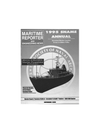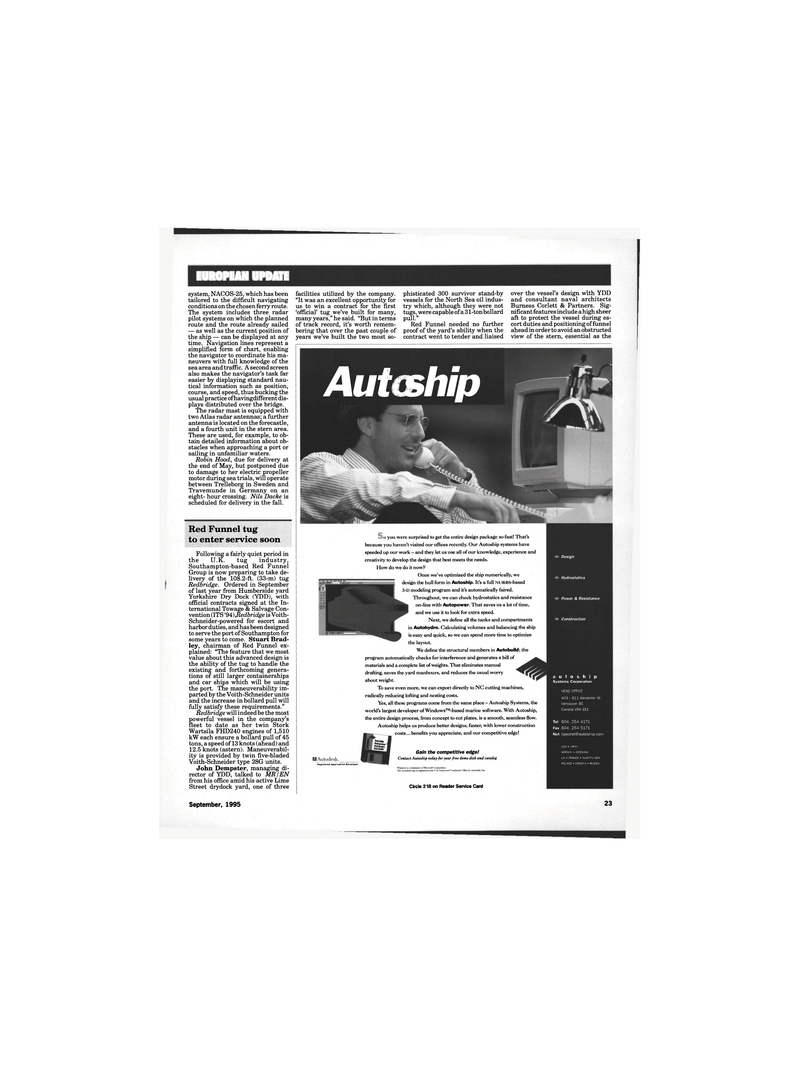
Page 21: of Maritime Reporter Magazine (September 1995)
Read this page in Pdf, Flash or Html5 edition of September 1995 Maritime Reporter Magazine
EUROPEAN UPDATE system, NACOS-25, which has been tailored to the difficult navigating conditions on the chosen ferry route.
The system includes three radar pilot systems on which the planned route and the route already sailed — as well as the current position of the ship — can be displayed at any time. Navigation lines represent a simplified form of chart, enabling the navigator to coordinate his ma- neuvers with full knowledge of the sea area and traffic. A second screen also makes the navigator's task far easier by displaying standard nau- tical information such as position, course, and speed, thus bucking the usual practice of havingdifferent dis- plays distributed over the bridge.
The radar mast is equipped with two Atlas radar antennas; a further antenna is located on the forecastle, and a fourth unit in the stern area.
These are used, for example, to ob- tain detailed information about ob- stacles when approaching a port or sailing in unfamiliar waters.
Robin Hood, due for delivery at the end of May, but postponed due to damage to her electric propeller motor during sea trials, will operate between Trelleborg in Sweden and
Travemunde in Germany on an eight- hour crossing. Nils Dacke is scheduled for delivery in the fall.
Following a fairly quiet period in the U.K. tug industry,
Southampton-based Red Funnel
Group is now preparing to take de- livery of the 108.2-ft. (33-m) tug
Redbridge. Ordered in September of last year from Humberside yard
Yorkshire Dry Dock (YDD), with official contracts signed at the In- ternational Towage & Salvage Con- vention (ITS '94)Jiedbridge is Voith-
Schneider-powered for escort and harbor duties, and has been designed to serve the port of Southampton for some years to come. Stuart Brad- ley, chairman of Red Funnel ex- plained: "The feature that we most value about this advanced design is the ability of the tug to handle the existing and forthcoming genera- tions of still larger containerships and car ships which will be using the port. The maneuverability im- parted by the Voith-Schneider units and the increase in bollard pull will fully satisfy these requirements."
Redbridge will indeed be the most powerful vessel in the company's fleet to date as her twin Stork
Wartsila FHD240 engines of 1,510 kW each ensure a bollard pull of 45 tons, a speed of 13 knots (ahead) and 12.5 knots (astern). Maneuverabil- ity is provided by twin five-bladed
Voith-Schneider type 28G units.
John Dempster, managing di- rector of YDD, talked to MR/EN from his office amid his active Lime
Street drydock yard, one of three facilities utilized by the company. "It was an excellent opportunity for us to win a contract for the first 'official' tug we've built for many, many years," he said. "But in terms of track record, it's worth remem- bering that over the past couple of years we've built the two most so- phisticated 300 survivor stand-by vessels for the North Sea oil indus- try which, although they were not tugs, were capable of a 31-ton bollard pull."
Red Funnel needed no further proof of the yard's ability when the contract went to tender and liaised over the vessel's design with YDD and consultant naval architects
Burness Corlett & Partners. Sig- nificant features include a high sheer aft to protect the vessel during es- cort duties and positioning of funnel ahead in order to avoid an obstructed view of the stern, essential as the
Red Funnel tug to enter service soon i> you were surprised to get the entire design package so fast! That's because you haven't visited our offices recently. Our Autoship systems have speeded up our work - and they let us use all of our knowledge, experience and creativity to develop the design that best meets the needs.
How do we do it now?
Once we've optimized the ship numerically, we design the hull form in Autoship. It's a full NURBS-based 3-D modeling program and it's automatically faired.
Throughout, we can check hydrostatics and resistance on-line with Autopower. That saves us a lot of time, and we use it to look for extra speed.
Next, we define all the tanks and compartments in Autohydro. Calculating volumes and balancing the ship is easy and quick, so we can spend more time to optimize the layout.
We define the structural members in Autobuild; the program automatically checks for interference and generates a bill of materials and a complete list of weights. That eliminates manual drafting, saves the yard manhours, and reduces the usual worry about weight.
To save even more, we can export directly to NC cutting machines, radically reducing lofting and nesting costs.
Yes, all these programs come from the same place - Autoship Systems, the world's largest developer of Windows™-based marine software. With Autoship, the entire design process, from concept to cut plates, is a smooth, seamless flow.
Autoship helps us produce better designs, faster, with lower construction costs...benefits you appreciate, and our competitive edge!
Gain the competitive edge!
Contact Autoship today for your free demo disk and catalog
Registered Application Developer
Circle 218 on Reader Service Card
Autcship
Design
Hydrostatics
Power & Resistance
Construction autoship
Systems Corporation
HEAD OFFICE 403 - 611 Alexander St.
Vancouver BC
Canada V6A 1E1
Tel 604. 254 4171
Fax 604. 254 5171
USA • JAPAN
NORWAY • GERMANY
UK • FRANCE • AUSTRALASIA
POLAND • CROATIA • RUSSIA
September, 1995 23

 20
20

 22
22
